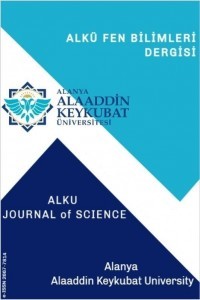Eriyik Biriktirme Yönteminde Farklı Üretim Parametrelerinin Mekanik Özelliklere Etkisi
Eriyik Biriktirme Yöntemi, polimer esaslı malzemelerin üst üste katmanlar şeklinde birleştirilmesi mantığı ile üretim yapan ve gün geçtikçe kullanımı yaygınlaşan bir eklemeli imalat teknolojisidir. Eriyik biriktirme yönteminde kullanılan cihazların düşük maliyetli olması, herhangi bir kesici takıma ihtiyaç duymadan karmaşık geometrili parçaların kısa üretim döngü sürelerinde üretilebilmesi ve düşük artık malzeme oranları gibi faktörler yöntemin sunduğu faydalar arasında gösterilebilmektedir. Yöntemde birçok farklı üretim parametresi bulunmakta ve bu parametreler ile üretilecek parçaların görsel ya da fonksiyonel özellikleri değişebilmekte ve amaca yönelik parça üretimi mümkün olmaktadır. Yöntemin kullanımının gittikçe yaygınlaşması, malzeme çeşitliliğinin artmasına da neden olmaktadır. Bu çalışmada, yeni nesil malzeme olarak adlandırılan ABS-plus termoplastik malzemesi kullanılarak eriyik biriktirme yönteminde test numuneleri üretilmiştir. Numuneler, farklı doluluk oranlarında ve farklı oryantasyon açılarında üretilerek çekme testlerine tabi tutulmuştur. Üretim parametrelerinin mekanik özelliklere etkisi incelenmiştir. Doluluk oranlarındaki artış ve farklı oryantasyon açısına göre mekanik özelliklerin önemli oranda değiştiği gözlenmiştir.
Anahtar Kelimeler:
Eklemeli İmalat, Eriyik Biriktirme Yöntemi, Üretim Parametreleri
___
- [1] Standard, A. S. T. M. (2012). F2792, standard terminology for additive manufacturing technologies. ASTM International, West Conshohocken.
- [2] Brenken, B., Barocio, E., Favaloro, A., Kunc, V., & Pipes, R. B. (2018). Fused filament fabrication of fiber-reinforced polymers: A review. Additive Manufacturing, 21, 1-16.
- [3] Ning, F., Cong, W., Qiu, J., Wei, J., & Wang, S. (2015). Additive manufacturing of carbon fiber reinforced thermoplastic composites using fused deposition modeling. Composites Part B: Engineering, 80, 369-378.
- [4] Fernandez-Vicente, M., Calle, W., Ferrandiz, S., & Conejero, A. (2016). Effect of infill parameters on tensile mechanical behavior in desktop 3D printing. 3D printing and additive manufacturing, 3(3), 183-192.
- [5] Anitha, R., Arunachalam, S., & Radhakrishnan, P. (2001). Critical parameters influencing the quality of prototypes in fused deposition modelling. Journal of Materials Processing Technology, 118(1-3), 385-388.
- [6] Ahn, S. H., Montero, M., Odell, D., Roundy, S., & Wright, P. K. (2002). Anisotropic material properties of fused deposition modeling ABS. Rapid prototyping journal, 8(4), 248-257.
- [7] Bellehumeur, C., Li, L., Sun, Q., & Gu, P. (2004). Modeling of bond formation between polymer filaments in the fused deposition modeling process. Journal of Manufacturing Processes, 6(2), 170-178.
- [8] Sun, Q., Rizvi, G. M., Bellehumeur, C. T., & Gu, P. (2008). Effect of processing conditions on the bonding quality of FDM polymer filaments. Rapid Prototyping Journal, 14(2), 72-80.
- [9] Reddy, B. V., Reddy, N. V., & Ghosh, A. (2007). Fused deposition modelling using direct extrusion. Virtual and Physical Prototyping, 2(1), 51-60.
- [10] Mohamed, O. A., Masood, S. H., & Bhowmik, J. L. (2017). Process parameter optimization of viscoelastic properties of FDM manufactured parts using response surface methodology. Materials Today: Proceedings, 4(8), 8250-8259.
- [11] Chacón, J. M., Caminero, M. A., García-Plaza, E., & Núñez, P. J. (2017). Additive manufacturing of PLA structures using fused deposition modelling: Effect of process parameters on mechanical properties and their optimal selection. Materials & Design, 124, 143-157.
- [12] Qattawi, A., Alrawi, B., & Guzman, A. (2017). Experimental optimization of fused deposition modelling processing parameters: a design-for-manufacturing approach. Procedia Manufacturing, 10, 791-803.
- [13] Li, H., Wang, T., Sun, J., & Yu, Z. (2018). The effect of process parameters in fused deposition modelling on bonding degree and mechanical properties. Rapid Prototyping Journal, 24(1), 80-92.
- [14] Tian, X., Liu, T., Yang, C., Wang, Q., & Li, D. (2016). Interface and performance of 3D printed continuous carbon fiber reinforced PLA composites. Composites Part A: Applied Science and Manufacturing, 88, 198-205.
- [15] Tanikella, N. G., Wittbrodt, B., & Pearce, J. M. (2017). Tensile strength of commercial polymer materials for fused filament fabrication 3D printing. Additive Manufacturing, 15, 40-47.
- [16] Tymrak, B. M., Kreiger, M., & Pearce, J. M. (2014). Mechanical properties of components fabricated with open-source 3-D printers under realistic environmental conditions. Materials & Design, 58, 242-246.
- [17] Bähr, F., & Westkämper, E. (2018). Correlations between Influencing Parameters and Quality Properties of Components Produced by Fused Deposition Modeling. Procedia CIRP, 72(1), 1214-1219.
- [18] Skowyra, J., Pietrzak, K., & Alhnan, M. A. (2015). Fabrication of extended-release patient-tailored prednisolone tablets via fused deposition modelling (FDM) 3D printing. European Journal of Pharmaceutical Sciences, 68, 11-17.
- [19] Esun. ABS-Plus. http://www.esun3d.net/products/143.html. Erişim Tarihi: Mart 15, 2019.
- [20] Stratasys. Materials. https://www.stratasys.com/materials. Erişim Tarihi: Mart 15, 2019.
- [21] Nuñez, P. J., Rivas, A., García-Plaza, E., Beamud, E., & Sanz-Lobera, A. (2015). Dimensional and surface texture characterization in fused deposition modelling (FDM) with ABS plus. Procedia Engineering, 132, 856-863.
- [22] Vairis, A., Petousis, M., Vidakis, N., & Savvakis, K. (2016). On the strain rate sensitivity of abs and abs plus fused deposition modeling parts. Journal of Materials Engineering and Performance, 25(9), 3558-3565.
- [23] Savvakis, K., Petousis, M., Vairis, A., Vidakis, N., & Bikmeyev, A. T. (2014, November). Experimental determination of the tensile strength of fused deposition modeling parts. In ASME 2014 International Mechanical Engineering Congress and Exposition(pp. V014T11A022-V014T11A022). American Society of Mechanical Engineers.
- Yayın Aralığı: Yılda 3 Sayı
- Başlangıç: 2019
- Yayıncı: Alanya Alaaddin Keykubat Üniversitesi
Sayıdaki Diğer Makaleler
Eriyik Biriktirme Yönteminde Farklı Üretim Parametrelerinin Mekanik Özelliklere Etkisi
Muhammed Talha SEVAL, Hande Nur ALP, Ayşe ÇELİK, Saadet AİŞEOĞLU, Mehmet MİMAN
Taş Kolonların Performans Analizi
Kaltoum ABDILLAHI AHMED, Kaveh DEHGHANIAN
The Similar and Dissimilar Spot Welding of 304 and 316L Austenitic Stainless Steels
İsmail TOPCU, Özgür ÇINAR, Ahmet Erdem ALYANAKOĞLU, Burcu Nilgün ÇETİNER, Arif Nihat GÜLLÜOĞLU
Enine Donatısız Betonarme Kirişlerin Kesme Mukavemetinin Çoklu Regresyon Modelleriyle Tahmini
